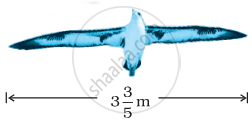Advertisements
Advertisements
Question
Re-arrange suitably and find the sum in each of the following:
Solution
\[ (\frac{3}{5} + \frac{9}{5}) + (\frac{- 7}{3} + \frac{7}{3}) + \frac{- 13}{15}\]
\[ = \left( \frac{3 + 9}{5} \right) + \left( \frac{- 7 + 7}{3} \right) + \frac{- 13}{15}\]
\[ = \frac{12}{5} + \frac{- 13}{15}\]
\[ = \frac{36 - 13}{15}\]
\[ = \frac{23}{15}\]
APPEARS IN
RELATED QUESTIONS
Subtract the first rational number from the second in each of the following:
Evaluate each of the following:
What should be added to \[\left( \frac{1}{2} + \frac{1}{3} + \frac{1}{5} \right)\] to get 3?
Multiply:
Simplify:
State, True Or False
`7/9=(7+5)/(9+5)`
Insert five rational number between:
`(2)/(5) and (2)/(3)`
Arrange the following rational numbers in ascending order.
`(10)/(9),(13)/(12) and (19)/(18)`
The diagram shows the wingspans of different species of birds. Use the diagram to answer the question given below:
| Albatross | Sea Gull |
 |
 |
How much longer is the wingspan of an Albatross than the wingspan of a Sea gull?
All decimal numbers are also rational numbers.
